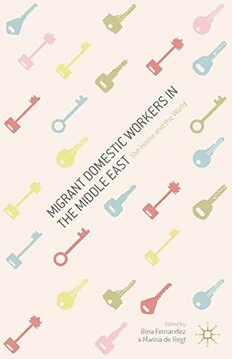
Migrant Domestic Workers in the Middle East: The Home and the World PDF
Preview Migrant Domestic Workers in the Middle East: The Home and the World
Migrant Domestic Workers in the Middle East This page intentionally left blank Migrant Domestic Workers in the Middle East The Home and the World Edited by Bina Fernandez and Marina de Regt migrant domestic workers in the middle east Copyright © Bina Fernandez and Marina de Regt, 2014. All rights reserved. First published in 2014 by PALGRAVE MACMILLAN® in the United States—a division of St. Martin’s Press LLC, 175 Fifth Avenue, New York, NY 10010. Where this book is distributed in the UK, Europe and the rest of the world, this is by Palgrave Macmillan, a division of Macmillan Publishers Limited, registered in England, company number 785998, of Houndmills, Basingstoke, Hampshire RG21 6XS. Palgrave Macmillan is the global academic imprint of the above companies and has companies and representatives throughout the world. Palgrave® and Macmillan® are registered trademarks in the United States, the United Kingdom, Europe and other countries. ISBN: 978-1 -1 37- 48210-5 Library of Congress Cataloging-i n-P ublication Data Migrant domestic workers in the Middle East : the home and the world / edited by Bina Fernandez and Marina de Regt. pages cm Includes bibliographical references and index. ISBN 978-1 - 137- 48210- 5 (hardback) 1. Women household employees—M iddle East—S ocial conditions. 2. Household employees—M iddle East—S ocial conditions. 3. Women foreign workers—M iddle East—S ocial conditions. 4. Foreign workers— Middle East—S ocial conditions. I. Fernandez, Bina. II. De Regt, Marina. HD6072.2.M628M54 2014 331.4'81640956—d c23 2014024785 A catalogue record of the book is available from the British Library. Design by Scribe Inc. First edition: December 2014 10 9 8 7 6 5 4 3 2 1 To all migrant domestic workers in the Middle East: that care work may be valued and borders won’t be barriers anymore. This page intentionally left blank Contents 1 Making a Home in the World: Migrant Domestic Workers in the Middle East 1 Bina Fernandez and Marina de Regt 2 Forging Intimate and Work Ties: Migrant Domestic Workers Resist in Lebanon 27 Amrita Pande 3 Degrees of (Un)Freedom: The Exercise of Agency by Ethiopian Migrant Domestic Workers in Kuwait and Lebanon 51 Bina Fernandez 4 Immobilized Migrancy: Inflexible Citizenship and Flexible Practices among Migrants in the Gulf 75 Pardis Mahdavi 5 The “Mama Mary” of the White City’s Underside: Reflections on a Filipina Domestic Workers’ Block Rosary in Tel Aviv, Israel 95 Claudia Liebelt 6 Creating a “New Home” Away from Home: Religious Conversions of Filipina Domestic Workers in Dubai and Doha 117 Naomi Hosoda and Akiko Watanabe 7 Caring for the Future in the Kingdom of Saudi Arabia: Saudi and Filipino Women Making Homes in a World of Movement 141 Nada Elyas and Mark Johnson viii ● Contents 8 “Shall We Leave or Not?”: Ethiopian Women’s Notions of Home and Belonging and the Crisis in Yemen 165 Marina de Regt Notes on Contributors 187 Index 191 CHAPTER 1 Making a Home in the World Migrant Domestic Workers in the Middle East Bina Fernandez and Marina de Regt For nearly half a century, the Middle East and, in particular, the Ara- bian Peninsula has become a major migration corridor for domes- tic workers from Asia and Africa. The large- scale employment of migrant domestic workers began following the oil boom in 1973. As a result of rapidly growing oil revenues, Saudi Arabia and the Persian Gulf states financed development projects in infrastructure, industry, and agri- culture, which attracted migrants from neighboring Arab countries and other parts of the world. Initially, the majority of migrants were single men, with women migrating for family reunification. The increasing demand for paid domestic labor led to an increase in the number of autonomous women migrants (Castles and Miller, 2003; Moukarbel, 2009). Domestic workers came predominantly from South and Southeast Asia (e.g., the Phil- ippines, India, Sri Lanka, Bangladesh, Nepal, and Indonesia), yet in the past decade, an increasing number of African women have also migrated to the Middle East. Most of them come from Ethiopia and Eritrea, but there are also women from Nigeria, Cameroon, Madagascar, Benin, and other African countries who work as domestics. In addition, while the major- ity of migrant domestic workers can be found on the Arabian Peninsula, they are also present in Lebanon, Israel, Jordan, Iraq, Syria (before the civil war), and Yemen (e.g., Jureidini, 2009; Moukarbel, 2009; Liebelt, 2011; Frantz, 2008; de Regt, 2008). The hierarchy of domestic workers at these destinations is often distinctly organized according to class and race. Upper- class families tend to employ Asian women and in particular Filipinas or Indonesian women, whereas
